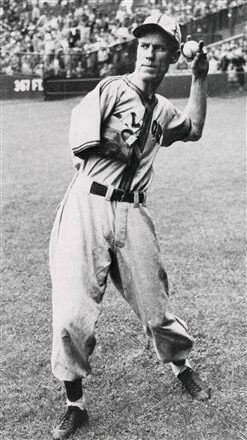Pete Gray: The One-Armed Wonder
He lost his right arm in a childhood accident - but that didn't stop him! The story of one-armed wonder Pete Gray - by baseball writer Norman L. Macht
Pete Gray was born Peter J. Wyshner Jr. on March 6, 1915, to Lithuanian immigrant parents in the coal country town of Nanticoke, Pennsylvania. Like most boys in those circumstances, he turned to baseball to “fit in” in America. Along the way, he changed his name to Pete Gray for the same reason.
Pete quickly found he had a good batting eye and could hit a pitch better than most other kids. But he suffered a setback when he was six years old that would have discouraged any dreams of being a ballplayer for most boys.
He fell off the running board of a moving truck when it stopped suddenly and his right arm was caught in the spokes of a wheel. The arm could not be saved and was amputated above the elbow.
A natural right-hander, Pete now had to learn to do everything left-handed. He quickly adapted to hitting that way and, with a regimen of exercises, built up the strength of his left arm until he could swing a heavy bat with one hand.
The One-Armed Outfielder
But playing any fielding position was a different challenge. Naturally fast on his feet, he practiced being an outfielder. Catching the ball was no problem, but what then? It took him years, but eventually he had a thin glove made and developed a way to tuck it quickly under the stub of his right arm and drop the ball out of it into his left hand.
Later he refined the move, flipping the ball into the air and dropping his glove, then catching it to make the throw.
In 1934 Gray started playing for a local semipro team, playing left field and batting third in the lineup. He now stood 6-foot-1 and weighed 169. He went to major league tryout camps, to no avail, and hoped that a scout may notice him, but nobody was interested.
He remained in semipro ranks and in 1940 earned a place in the semipro “big leagues” with the Brooklyn Bushwicks, where he drew big crowds for Sunday doubleheaders while batting .350.
A Minor League Offer
That brought him his first offer from a minor league team: Three Rivers in the Canadian-American League, in 1942. He quickly proved he was more than just a curiosity, batting .381. When the league folded in 1943, he was signed by the Memphis Chicks of the Class AA Southern Association.
He quickly became a fan favorite, drawing large crowds at every park in the league for his hustling “One-Armed Wonder” style. The Chicks finished last, but Gray batted .289. He had an even better year in 1944, batting .333 with 68 stolen bases,
By now, with rosters thoroughly depleted by the war, major league scouts were no longer ignoring the “One-armed Wonder.” The St. Louis Browns, drawing poorly at the gate despite having won their only American League pennant in 1944, looked at the Chicks’ attendance figures as much as Gray’s stats, and paid the Chicks $20,000 for his contract.
The Big Leagues
Starting in left field at home against the Detroit Tigers, Gray made his major league debut on April 17, 1945. He singled in four at-bats in a 7-1 Browns victory. But big league pitchers quickly spotted his weaknesses and adjusted.
Base-runners took advantage of the delay in his getting rid of the ball after fielding it. His playing time diminished with his batting average. In 77 games he batted .218.
In 1942, when Pete was 27, a friend had written to the Philadelphia Athletics suggesting they give the youngster a tryout. The A’s had finished last, and lost a lot of young players in the military draft. Gray arrived at Shibe Park and asked to see Connie Mack. While he waited, Mack’s son Roy saw him. “Where’s the kid we’re supposed to look at?” Roy said.
Pete Gray played for a range of clubs, including the St. Louis Browns
Gray said he was the one. As he related the story to John Steadman of the Baltimore Sun, “I was told then that Connie was busy and couldn’t waste his time seeing me.”
Two years later, at the Philadelphia writer’s dinner, Gray was honored as the most courageous athlete of the year, Connie Mack was there and said to him, “There was a one-armed fellow one time who wanted a tryout. Are you the same boy?”
Gray said he was. Later he said his most enjoyable day in baseball was July 4, 1945, when he had three hits against the A’s, the last a ninth-inning single that drove in the tying and winning runs.
In 1946 the major leaguers returned from the war and Pete Gray returned to the minor leagues for a few years, then back to the semi-pros until retiring in 1953.
Pete Gray died in Nanticoke, Pennsylvania, on June 30, 2002.


